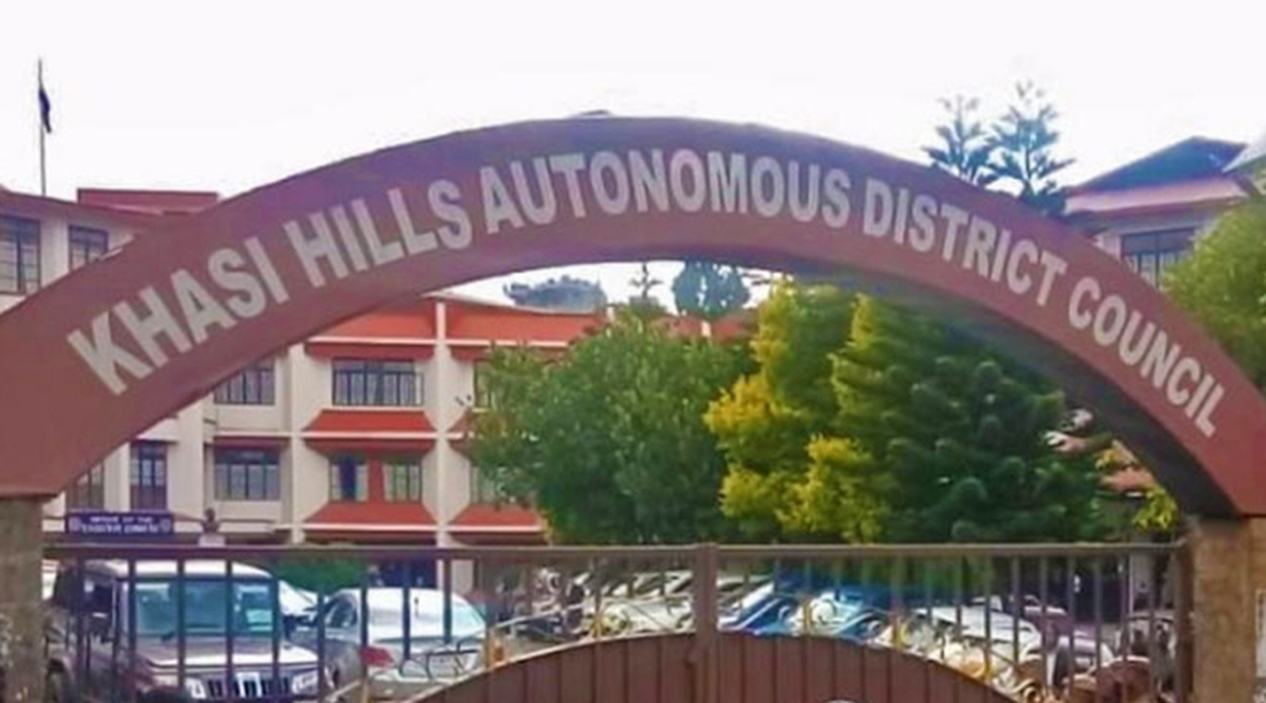
Copyright infringement not intended
Context: The Khasi Hills Autonomous District Council (KHADC) in Meghalaya expressed concern over the influx of people from neighbouring States, especially Manipur, where violence has erupted between the Naga and Kuki communities. The KHADC said that the migrants pose a threat to the identity and culture of the indigenous Khasi people, who constitute the majority of the population in the district.
Details
- The recent violence in Manipur has forced many people from the tribal communities to flee their homes and seek shelter in other States or even abroad. One of the places where they have found refuge is Shillong, the capital of Meghalaya, and its surrounding areas.
- This mass migration has raised some concerns among the local authorities and the traditional institutions of the Khasi people, who inhabit the Khasi Hills region. The Khasi Hills Autonomous District Council (KHADC) has taken note of this situation and has issued some directives to the Dorbar Shnongs, which are the customary village or locality councils of the Khasi people.
- The KHADC has also urged the homeowners in the Khasi Hills not to rent out their properties to outsiders, especially those from Manipur, as there are reports that some of them are trying to buy land in Meghalaya.
- This could pose a threat to the land rights and identity of the indigenous Khasi people, who have been struggling to protect their culture and autonomy from external influences.
- The KHADC has also suggested that the Meghalaya Government should set up relief camps for the people from Manipur who have fled violence so that they can be provided with basic amenities and security. This would also help in monitoring their movement and preventing them from settling down permanently in Meghalaya.
- The KHADC has expressed its sympathy and solidarity with the tribal people of Manipur who have suffered due to the communal clashes but has also asserted its duty to safeguard the interests and welfare of the Khasi people.

Khasi Hills Autonomous District Council (KHADC)
- The Khasi Hills Autonomous District Council (KHADC) is one of the three autonomous district councils in Meghalaya, a state in northeastern India.
- The KHADC was established in 1952 under the Sixth Schedule of the Constitution of India, which grants special rights and powers to tribal communities in certain regions of the country.
- The KHADC covers an area of about 6,000 square kilometres and has a population of about 1.2 million people, mostly belonging to the Khasi tribe.
The main features of the KHADC are:
- It has legislative, executive and judicial powers over matters relating to land, forests, water, agriculture, fisheries, education, health, social welfare and customary laws of the Khasis.
- It has 30 elected members, including four nominated members, who serve for a term of five years. The chief executive member (CEM) is the head of the council and is elected by the members.
- It has its budget and can levy taxes and fees on certain subjects within its jurisdiction.
- It can make laws and regulations on matters specified in the Sixth Schedule, subject to the approval of the governor of Meghalaya and the assent of the president of India.
- It can make recommendations to the state government or the central government on matters affecting the interests of the Khasis.
- It acts as a bridge between the state government and the traditional institutions of the Khasi society, such as the Syiemships (chiefdoms), Dorbars (village councils) and Kur (clans).
- It is responsible for ensuring that the customary laws and practices of the Khasis are respected and harmonized with modern laws and administration.
Significance
- It preserves and protects the identity, culture, traditions and customs of the Khasi tribe, which is one of the oldest and largest indigenous groups in India.
- It empowers the Khasis to manage their affairs and resources according to their own needs and aspirations.
- It promotes the socio-economic development and welfare of the Khasi people, especially in rural areas where they constitute a majority.
- It fosters a sense of unity and harmony among the different sub-groups and clans of the Khasis, as well as with other communities in Meghalaya and beyond.
Challenges
Lack of adequate financial resources and autonomy
- The KHADC depends largely on grants from the state and central governments for its functioning and development activities.
- It has limited powers to raise its revenue through taxation or fees.
- It has to seek approval from the governor or the state government for implementing its laws and regulations, which may cause delays or conflicts.
Interference from political parties and vested interests
- The KHADC elections are often influenced by political parties and candidates who have affiliations or agendas that may not align with the interests of the Khasi people.
- The KHADC members may also face pressure or inducements from various groups or individuals who seek to benefit from the council's decisions or resources.
Lack of coordination and cooperation with other stakeholders
- The KHADC sometimes faces difficulties in working with other autonomous district councils, state government departments, traditional institutions, civil society organizations and other stakeholders who have a stake in the development and welfare of the Khasi Hills region.
- There may be overlapping or conflicting jurisdictions, roles and responsibilities among these entities, leading to confusion or disputes.
Lack of awareness and participation among the public
- The KHADC suffers from a lack of awareness and appreciation among the general public about its functions, achievements and challenges.
- Many people are unaware of their rights and duties as citizens under the KHADC's jurisdiction. There is also a low level of participation and engagement among the public in the council's activities, such as elections, consultations, feedback and grievance redressal.
The way forward for the KHADC is to overcome these challenges and strengthen its role as a representative and effective institution for the Khasi people.
Some of the possible steps that can be taken are:
Enhancing financial resources and autonomy
- The KHADC should seek more funds from the state and central governments for its development projects and schemes.
- It should explore ways to generate its revenue through rational taxation or fees on various services or activities within its domain.
- It should demand more autonomy and discretion in implementing its laws and regulations without undue interference or delay from higher authorities.
Ensuring accountability and transparency
- The KHADC should ensure that its members and officials are accountable and transparent in their conduct and performance.
- It should adopt measures to prevent corruption, nepotism, favouritism or misuse of power or funds.
- It should ensure that its decisions and actions are based on merit, evidence and consultation with relevant stakeholders.
Improving coordination and cooperation with other stakeholders
- The KHADC should improve its coordination and cooperation with other autonomous district councils, state government departments, traditional institutions, civil society organizations and other stakeholders who have a stake in the development and welfare of the Khasi Hills region.
- It should establish mechanisms for regular dialogue, consultation, collaboration and conflict resolution among these entities.
- It should respect and uphold the rights and interests of other communities who live in or visit its territory.
Increasing awareness and participation among the public
- The KHADC should increase its awareness and participation among the general public about its functions, achievements and challenges.
- It should use various media platforms, such as newspapers, radio, television, social media, websites etc., to disseminate information and updates about its activities.
- It should also encourage and facilitate public involvement in its activities, such as elections, consultations, feedback and grievance redressal.
Conclusion
- The KHADC is a unique institution that has a vital role in safeguarding and advancing the interests of the Khasi people. It should strive to overcome its challenges and realize its potential as a model of democratic governance that respects diversity, promotes development and fosters harmony.
Must-Read Articles:
Khasi Tribe: https://www.iasgyan.in/daily-current-affairs/khasi-tribe
Khasi Autonomous District Council: https://www.iasgyan.in/daily-current-affairs/khasi-autonomous-district-council
|
PRACTICE QUESTION
Q. What is the name of the traditional institution of governance that works in collaboration with the Khasi Hills Autonomous District Council (KHADC)?
1. Dorbar Shnong
2. Syiemship
3. Nokma
4. Nobia
How many of the above statements is/are correct?
A) Only 1
B) Only 2
C) Only 3
D) All
Answer: B
Explanation: The KHADC recognizes and respects the role of the traditional institutions of governance that have been existing among the Khasi people for centuries, such as the Dorbar Shnong (village council), Syiemship (chiefdom), Lyngdohship (priesthood), etc. These institutions work in collaboration with the KHADC to ensure the effective administration and preservation of the customary laws and practices of the Khasi community.
|

https://www.thehindu.com/news/national/other-states/ensure-manipur-refugees-return-meghalaya-tribal-council-tells-traditional-local-bodies/article67014972.ece















